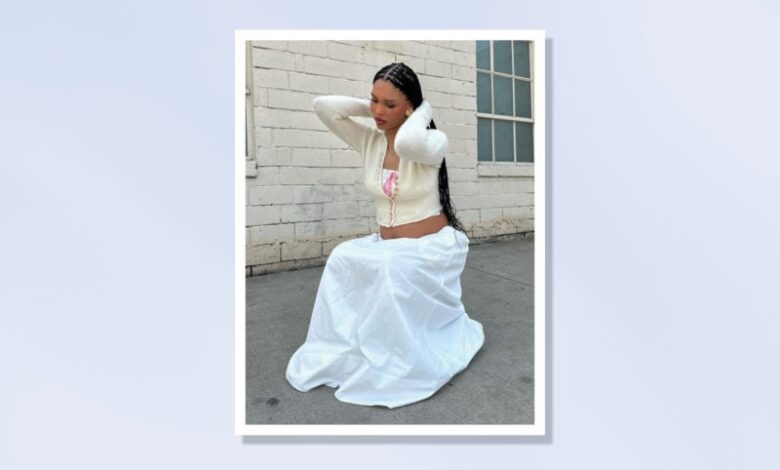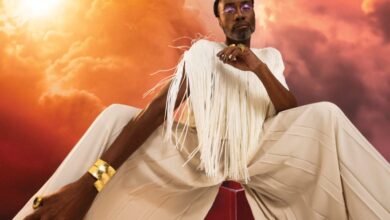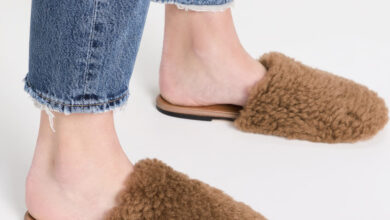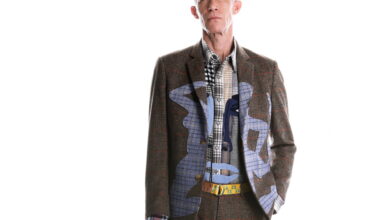Pregnancy Braids Are an Act of Self-Care

[ad_1]
Why Nara Smith, Beyoncé and more rely on box braids to get them through pregnancy.
This is Texture Talk, our long-running column that deep dives into the dynamic world of curly hair, from crowns of curls that are free flowing to strands that are tucked away in a protective style.
Model, amateur home chef and expectant mother Nara Smith recently ditched her signature bob haircut and debuted long, knotless box braids in a video asking followers to share baby name suggestions. While it’s not uncommon for women to change their look now and then, many Instagram and X users had suspicions about this particular aesthetic shift. After her husband Lucky Blue Smith’s sister commented “When the braids come out, I know it’s almost time!!” she seemingly confirmed what others suspected: The soon-to-be mother of three is super close to her due date.
Women are no strangers to pragmatic styling (see: the going out top or the subway shirt), but end-of-term pregnancy calls for even more meticulous planning and coordination. On top of packing a hospital bag and prepping the nursery, expectant mothers with textured hair have an extra task to complete before they welcome their baby: having their “delivery braids” installed.
“I just don’t want to be dealing with washing my hair or combing it out or doing anything,” Nara explains in a TikTok documenting her transition from blunt bob to long braids. “So I always get braids or a different protective style before I go into labour.”
“Delivery braids,” also know as “pregnancy braids,” “labour braids,” and “maternity braids,” are a hairstyles that many Black expectant moms opt for in preparation for giving birth. Along with Smith, celebrities like Beyoncé, Rihanna, Serena Williams and Halsey have all been pictured braided up at the end of their third trimesters.
“Often, pregnant clients will say ‘I need my hair braided because I won’t have time to style it when the baby comes,’” says Stephon John, a Toronto-based braid artist with over 20 years of experience. “A lot of people tend to get protective styles a few weeks before going into labour.”
Black women know that tending to natural hair is a labour of love, but this often requires more time and energy than a new mom can give. So, rather than worrying about refreshing a wash-and-go or sweating out a silk press, pregnant gals often opt for lower-maintenance delivery styles to free up time for other things as their routine changes. While there is no technical difference between pregnant and non-pregnant clients’ braids, this style has been playfully dubbed “delivery braids” by those online as it’s often a visual clue that a woman’s due date is rapidly approaching.
In addition to box braids, John’s pregnant clients ask for other protective styles like cornrows and boxer braids, all of which she recommends leaving in for no more than eight weeks to prevent unnecessary tension on the scalp.
As both timesavers and culturally significant beauty practices, these braided styles serve multiple functions for expectant mothers. An article by Terri Huggins refers to the braiding process as both a “calming” and “nesting” ritual in Black women’s pregnancies that helps prepare them for the lovely chaos that new babies bring. For many women, the demands of motherhood mean hair care simply can’t be a priority.
@naraazizasmith Final stretch 🥹 Comment your suggestions! 🫶🏽 #coupletok #pregnancy #babynames #marriage #fitcheck #fypシ #outfitideas ♬ End of Beginning – Djo
“Motherhood means a lot of time focusing on your newborn, so women have less time to take care of themselves the way they used to,” John says. “It’s self-care since these protective hairstyles limit how many things they have to do for themselves during such a busy time.”
Even though new moms might have less time for their beautification rituals, it would do them a disservice to deny the role that appearance plays in self-esteem, especially when dealing with the fluctuating hormones that are part of pregnancy. With so many unknowns facing women entering their fourth trimesters — the three-month period after delivery when mothers balance changes to their bodies and hormones with the demands of an infant — it’s important to prioritize self-care. Protective styles allow women to feel like themselves during the new experience of motherhood since nearly no effort is required to keep braids looking and feeling fresh.
“Those first pics with your newborn baby are memories you’ll treasure forever,” writes Kristen Bingle on the importance of delivery braids. “And if your hair is looking stylish in a stunning protective style, you’ll love the pics even more.”
The process of getting one’s hair braided also provides a connection to community and cultural practices that can be meaningfully grounding as you bring in the next generation. Many Black women can recall sitting in a braiding chair as children, and as adults, allowing someone else to take care of them. Feeling the cool metal of the tail comb on your scalp, smelling the Blue Magic grease and hearing the TV blare your third movie of the day are all memories associated with this nearly day-long beauty practice. This process is so important that during COVID it wasn’t uncommon to learn the skill to support family members when restrictions prevented Black women from reaching their stylists.
When women prepare to become the primary caregiver for a new life, they should be offered endless care and support by those around them. Through delivery braids, Black women can feel cared for by their communities, and assured that they are not alone in their motherhood journey. And they can look really cute in their baby’s first photos.
More Texture Talk
Texture Talk
Hair
Celebrity Beauty
[ad_2]
Source link






